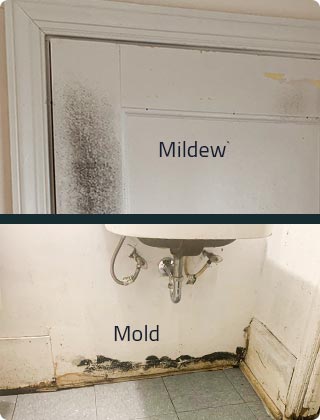
Mold or Mildew? Why It Matters
You spot a strange patch on your bathroom ceiling. It's dark, maybe a little fuzzy. Is it mold? Is it mildew? Does it even matter?
Yes, it matters a lot.
While mold and mildew are both types of fungi, they behave very differently. One might just need a quick scrub. The other could be a sign of deeper moisture problems, potential health risks, and costly repairs.
Understanding the difference isn't just about curiosity, it's about protecting your home, your health, and your wallet.
In this guide, we'll break down:
- How to visually tell mold from mildew
- Where each one tends to grow
- What risks they pose
- And when it's time to call in a professional
Let's clear the air - literally.
Visual Showdown: What They Look Like
When it comes to spotting the difference between mold and mildew, your eyes are your first line of defense. Here's how to tell them apart at a glance:
Mold: The Deep Invader
- Color: Black, green, blue, or even red
- Texture: Fuzzy, slimy, or thick
- Growth Pattern: Irregular patches that penetrate surfaces
- Common Spots: Behind walls, under sinks, in HVAC systems
Mold tends to grow into materials like wood, drywall, or insulation. If it looks like it's eating the surface, it probably is.
Mildew: The Surface Squatter
- Color: White, gray, or light brown
- Texture: Powdery or fluffy
- Growth Pattern: Flat, spreading in a circular or patchy pattern
- Common Spots: Shower tiles, windowsills, fabric, bathroom ceilings
Mildew usually stays on the surface and is easier to wipe away, but it's still a sign of excess moisture.
| Feature | Mold | Mildew |
|---|---|---|
| Color | Black, green, blue, red | White, gray, light brown |
| Texture | Fuzzy, slimy, thick | Powdery, fluffy |
| Growth | Deep, spreads irregularly | Surface-level, flat patches |
| Smell | Musty, strong, earthy | Mild, stale |
| Risk Level | High (health + structural) | Low to moderate |
Where They Hide: Common Hotspots in Your Home
Mold and mildew don't just appear randomly - they thrive in specific conditions. Knowing where to look can help you catch a problem early, before it spreads or causes damage.
Mold's Favorite Hiding Places
Mold needs moisture, warmth, and organic material to grow. It often develops in areas you don't see every day, such as:
- Behind drywall or wallpaper
- Under sinks and around leaky plumbing
- Inside HVAC systems and ductwork
- In basements and crawl spaces
- Around roof leaks or poorly sealed windows
These are places where moisture can linger unnoticed, giving mold the perfect environment to dig in and spread.
Where Mildew Shows Up
Mildew prefers damp, warm surfaces with poor airflow. It's more likely to grow in visible, high-humidity areas like:
- Shower walls and bathroom ceilings
- Window sills and frames
- Tile grout and caulking
- Damp towels, curtains, or upholstery
- Laundry rooms and poorly ventilated closets
Unlike mold, mildew usually stays on the surface, but it's still a red flag for excess moisture.
Health Impact: Which One Should You Worry About?
Not all fungi are created equal, especially when it comes to your health. While both mold and mildew can cause discomfort, mold poses a significantly higher risk.
Mold: A Serious Health Threat
Mold exposure can trigger a wide range of symptoms, especially in people with allergies, asthma, or weakened immune systems. According to the CDC, mold can cause:
- Nasal congestion, coughing, and wheezing
- Eye and skin irritation
- Asthma flare-ups
- In severe cases, lung infections in immunocompromised individuals
Long-term exposure to certain types of mold, like Stachybotrys chartarum (black mold), may even contribute to chronic respiratory issues and neurological symptoms.
Mildew: Mild but Not Harmless
Mildew is less aggressive, but it's not completely harmless. Prolonged exposure can still lead to:
- Mild respiratory irritation
- Allergic reactions (sneezing, itchy eyes)
- Skin sensitivity in some individuals
While mildew is more of a nuisance than a threat, it often signals excess moisture, the same condition that allows mold to thrive.
If you're experiencing unexplained allergy symptoms or breathing issues at home, don't ignore them. Mold might be growing where you can't see it, and the longer it's left untreated, the worse the health risks become.
Quick ID Guide: DIY or Call a Pro?
Not sure if that suspicious spot is mold or mildew? Here's how to figure it out, and when to bring in the mold experts.
Step 1: Look Closely
Color & Texture:
- Mildew is usually white or gray and powdery.
- Mold is darker (black, green, or blue) and fuzzy or slimy.
Location:
- Mildew grows on damp surfaces like tiles or fabric.
- Mold often hides behind walls, under floors, or in HVAC systems.
Step 2: Smell It
- Mildew has a musty but mild odor.
- Mold smells stronger, usually earthy, pungent, and persistent.
Step 3: Try the Bleach Test
Dab a small amount of diluted bleach on the spot:
- If it lightens quickly, it's likely mildew.
- If it stays dark, it could be mold.
Caution: This test isn't foolproof, and it won't detect hidden mold behind walls or under floors.
Step 4: Know When to Call a Pro
If you notice any of the following, it's time to contact a certified mold inspector:
- Recurring growth after cleaning
- Musty smell with no visible source
- Water damage or leaks
- Health symptoms like coughing, sneezing, or headaches at home
Professional testing can detect hidden mold, identify the species, and guide you on safe removal.
Prevention That Actually Works
The best way to deal with mold and mildew? Don't let them grow in the first place. Prevention is all about controlling moisture and improving airflow, two things every home can manage with the right habits.
Control Humidity
To effectively control indoor humidity, it's important to maintain levels below 50%. This helps prevent mold growth and other moisture-related issues. In areas that tend to be damp, such as basements, using a dehumidifier can be especially helpful. Additionally, make sure to run exhaust fans in bathrooms and kitchens during and after use to remove excess moisture from the air.
Addressing water leaks promptly is also crucial. Even small drips, like those under a sink, can lead to hidden mold growth behind walls if left unchecked. By taking these steps, you can create a healthier and more comfortable indoor environment.
Improve Airflow
To improve airflow in your home, start by opening windows whenever the weather permits. This allows fresh air to circulate and helps reduce indoor pollutants. Avoid blocking air vents with furniture or other objects, as this can restrict airflow and reduce the efficiency of your heating and cooling systems.
Additionally, make sure that furniture isn't placed directly against walls, as this can trap moisture and limit air movement. In rooms that tend to feel stuffy or closed off, use ceiling fans or portable fans to keep the air moving. These simple steps can significantly enhance ventilation and contribute to a healthier indoor environment.
Clean Smart
To clean smart and prevent mold and mildew, make it a habit to regularly wipe down shower walls and bathroom tiles. This helps remove moisture and soap residue that can encourage mold growth. In high-moisture areas like bathrooms and kitchens, opt for mold-resistant materials such as specially formulated paint, caulk, and drywall to add an extra layer of protection.
It's also important to keep fabrics clean and dry. Wash and thoroughly dry items like towels, curtains, and rugs on a regular basis, as mildew thrives in damp cloth. By staying on top of these simple cleaning habits, you can maintain a fresher, healthier home environment.
Stay Vigilant
Make it a routine to inspect hidden or less-visible areas at least once a month. Focus on spots like under sinks, behind appliances, and around windows, where moisture can accumulate unnoticed. These areas are often the first to show signs of trouble.
Also don't underestimate your sense of smell, a musty odor is often an early warning sign of mold. Catching these issues early can save you time, money, and potential health concerns down the line.
Don't Guess - Test
Mold and mildew may look similar at first glance, but the difference between them can have serious consequences for your health and your home. Mildew is usually a surface-level nuisance. Mold, on the other hand, can be a sign of deeper moisture problems and a real threat to indoor air quality.
If you're unsure what you're dealing with, don't leave it to guesswork. A quick wipe might remove mildew, but mold often hides where you can't see it, like behind walls, under floors, or inside your HVAC system.
When in doubt, test it out.
At O2 Mold Testing, we specialize in fast, accurate mold inspections that give you clear answers and peace of mind. Whether you're a homeowner, renter, or property manager, we're here to help you breathe easier.
Think you've got mold?
Contact O2 Mold Testing today and schedule your professional inspection.


